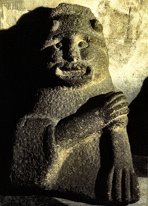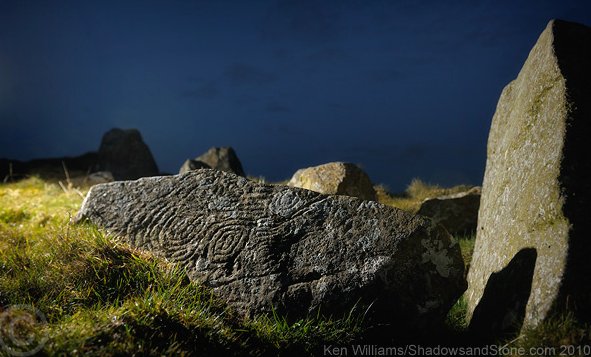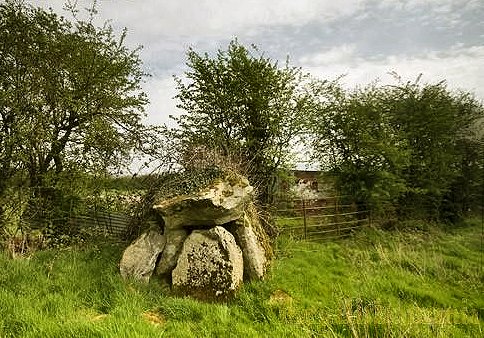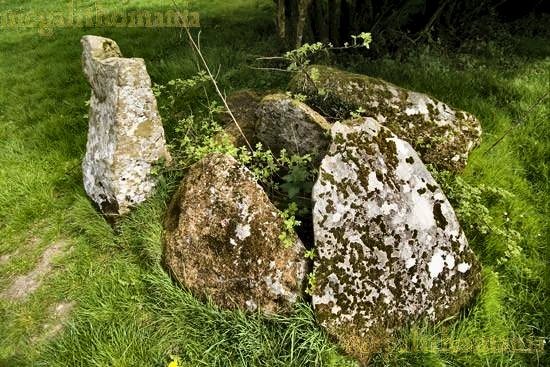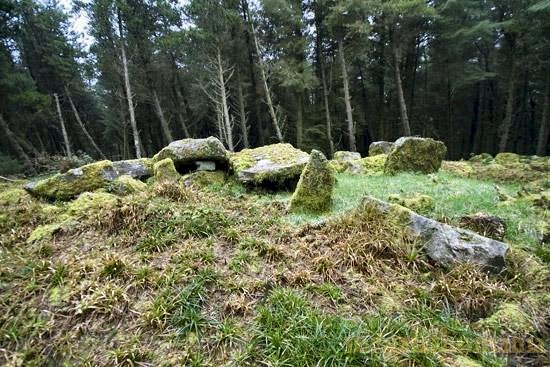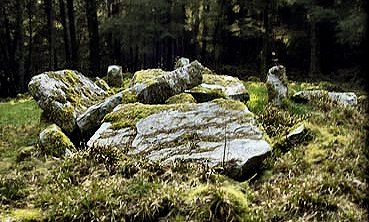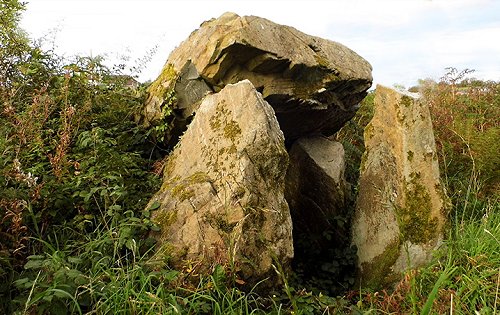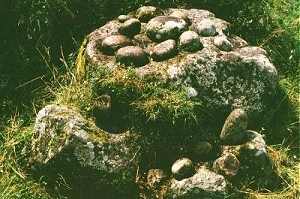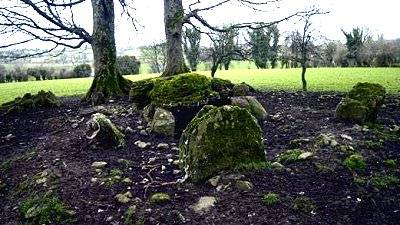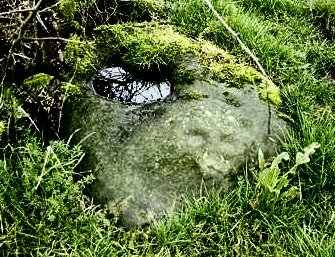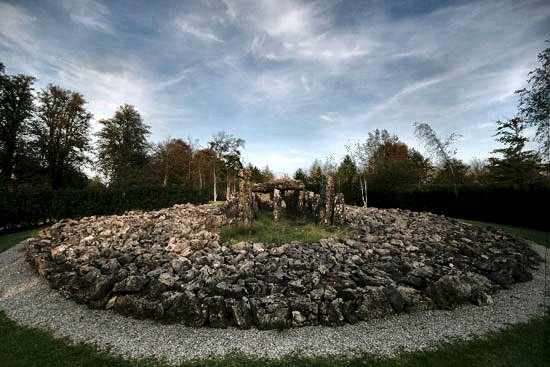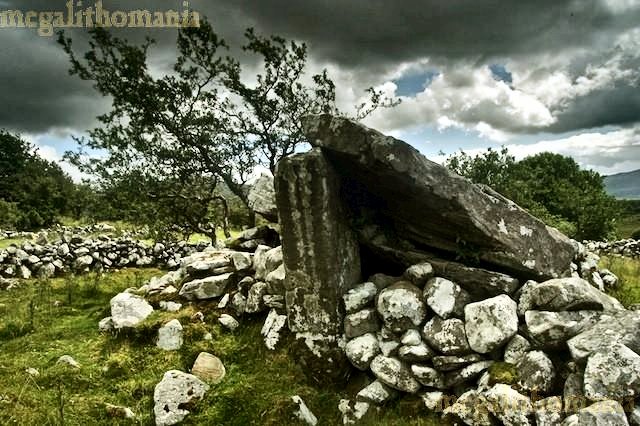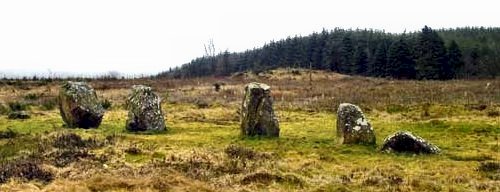county list
|
Turn smartphone to horizontal view.
Place-names in italics refer to listed entries. Convert Irish Grid references to Latitude/Longitude |
|
A wrecked chamber is surrounded by a partly-ruined kerb measuring some 10 metres in diameter. A niche or recess (two sidestones and a backstone) of the chamber survives, and the passage seems to have faced N towards Slieve Glah. A recumbent stone is decorated.
A few metres N of the kerb is a henge whose fosse (ditch) is clearly visible and whose banks are up to 1.5 metres high. ~ To the SE in the same townland (N 471 997) are the remains of a small portal-tomb whose one remaining portal stone is just 1 metre tall. The chamber is just 1 metre square, and the capstone lies to one side of the tomb, behind which is a pile of stones. Local hearsay has it that the capstone was thrown off the tomb by a local he-man for a bet. Whether this is a true story or the folkloric remnant of a legend of giants is anyone's guess: the site, like many others, is known as "The Giant's Grave". ~ At N 470 997 are the remains of a court-tomb destroyed well within living memory by a farmer who wanted to plant a hedge, seemingly unaware of the tomb on his own land. A couple of the stones from the tomb can still be seen in the hedge, notably a fine pointed specimen which was probably the backstone of the gallery. ~ 7.5 km SSW is a portal-tomb at Aghawee (N 437 928). Somewhat obscured by brambles, the chamber of the tomb is some 1.5 metres high. The capstone is broken in two, and has been replaced since it was removed to free a trapped calf. The stone leaning against the tomb on the left of the photo below does not belong to the structure, or is not in its original position.
Burren:
Wedge-tombs, portal-tomb, etc. click
on the thumbnail for a larger picture Approached from a
track running into dreary conifer plantation, "The Giant's
Grave" is a fine, large and well-preserved example with
a gallery over 7 metres long, divided by a high septal slab
into a long portico and a large main chamber. The gallery is
covered by 5 roofstones, 3 of which cover the main chamber,
and one of which has chock-stones. The front capstone has a
series of depressions which may be artificial cup-marks. Two
of the front orthostats of the façade lean together to form
a triangular entrance to the antechamber. The septal slab has
a gap at the bottom of the N end which seems artificial. The
tomb resembles some of the large gallery-tombs (allées-couvertes)
of France, and is well worth the trouble of the search. NOTE: 'Burren' comes from the Irish for a stony place, and is a not-uncommon place-name. This tomb is not in THE Burren of county Clare, where there are dozens of typical Irish wedge-tombs. ~ The stones visible on the skyline to the S of the wedge-tomb (H 082 350) are the jagged remains of a court-tomb in Legalough - including half the forecourt, good entrance-jambs and a sill-stone. 100 metres W is another wedge-tomb, more typically Irish than that in Burren, and affording splendid views, but with no roofstones. ~ 2.4
km SSW of Legalough in Mullaghboy (H 070 330) In a field
behind a large earthfast rock with a large slab leaning against
it, is a court-tomb fairly good condition, and with much cairn
material around the very overgrown gallery. The court is at
the west end of the long cairn and is somewhat confusing, because
the stones don't seem to form a definite shape. It is possible
that there is a second, shallow court built across the original
wider court. ~ Other tombs lurk in the townland of Burren, including (H 077 345) an almost intact wedge-like portal-tomb with a three-metre high cairn; and another portal-tomb at H 075 352, with two enormous outward-splaying portal-stones and a low door-stone. The gap above the door has been bricked up. One of the chamber walls has disappeared and the enormous, thin slab that was the capstone now leans against the other chamber wall. Half of the triangular gap formed by this is also bricked up, leaving a little doorway. This is reminiscent of the tombs of the French causses which have been made into shepherd-huts. It is known as The Calf-House, because it was part of a farmstead. ~ At H 074 353 (some 500 metres WNW of The Giant's Grave on Tullygobban Hill) is a fairly large wedge-tomb whose gallery is about 10 metres long and 2 metres wide. Many of the structural stones have been removed, but it is impressive even so. There are two large entrance stones, and some side slabs remaining in the front section of the gallery.
The rear of the tomb is far more imposing with two large (but broken) roof slabs in place, the larger being over 2 metres square. Around the rear wall slabs there are a few small stones which may be very diminutive or vestigial double walling. Other stones 3 metres or so from the rear of the gallery may be the remains of the kerb. ~ At H 075 353 there is a boulder-burial. Click the above picture to see it. Recently - and long since my last visit to the area - a signposted megalithic trail through the forest has been established, indicating many interesting features. Besides the tombs mentioned above are mediæval enclosures, a promontory fort, many hut sites, a boulder burial and natural features such as glacial erratics. Although the sites are signposted there are no information boards. A booklet on the trail is locally available and can be read on this CD ROM by clicking on the above link to 'The Calf-House'. ~ 2.4 km ENE is Clyhannagh court-tomb, see under Kilrooskagh portal-tomb, county Fermanagh. Cohaw:
Double-court tomb click
on the thumbnail for a ground-level view A good example of a double- (or dual-) court tomb, 5.6 km ESE of Cootehill, built as two single-court tombs back-to-back, standing in a rectangular cairn 25 metres long. Each semicircular forecourt (N and S) leads into a 2-chambered gallery with sill-stones and jambs. A fifth chamber has been contrived in the space between the ends of each gallery. Stone pegs in the forecourts mark post-holes, suggesting an awning over the ceremonial spaces. Drumhawnagh:
Portal-tomb Close to the road 6.4 km SSW of Ballinagh (Bellanalagh), this tomb has suffered greatly in recent times. Firstly a concrete shed was built beside it. Then a sidestone was removed to free a calf which had become trapped inside the polygonal chamber. This caused the capstone (almost two metres square) to slip. The sidestone was replaced by order of the parish priest, but commitment did not extend to the effort required to re-instate the slipped capstone - and, since then, the concrete shed has given way to a pretentious modern dwelling which intimidates the already-mutilated megalith. A calf got similarly trapped in a fine portal-tomb at Aghawee (8.4 km E) and the fine capstone, already broken in two, was hurled on the ground in order to free the beast. In Ireland cattle are the only true 'heritage': the bovine is almost divine. ~ Less than 800 metres to the W, behind a house on the E side of a by-road, in Middletown, is another "Druid's Altar" with a capstone 1.7 metres long and portal stones one metre apart and the usual 1.8 metres high. It is, however, partly obscured by bushes and littered around, as much of Ireland, by domestic refuse. The wallstones of the chamber are about 1.5 metres long and 1 metre tall, thus setting the capstone at severe angle. The back-stone is missing. The capstone has been broken, and the portion extending beyond the portal-stones has gone. My colleague Tom FourWinds reports that you can tell this from the notches in the side-stones made to hold the capstone, which still sits comfortably in the V-shaped hollows. This piece of megalithic ingenuity was devised to stop the steeply-inclined capstone from slipping back.
Drumeague:
Wedge-tomb Duffcastle:
Portal-tomb 3.2 km ENE of Kilnaleck, 90 metres to the S of a by-road leading to Ballyjamesduff, this tomb is impressive despite partial wrecking. The large capstone is nearly 2.4 metres long, and has tipped into the chamber. One of the sidestones has collapsed, and one of the portal-stones is missing. The remaining portal-stone is the usual 1.8 metres high, and the door-slab is still in position. Gartnanoul:
Court-tomb This dual-court tomb is well-preserved and well-signposted in a sylvan setting. The northern tomb has a court 4 metres wide and 3 metres deep leading to a 4 metre-long gallery divided into two chambers by a low jamb. The southern tomb is very similar. There is a gap of a whole 12 metres between the galleries, making the whole structure nearly 30 metres long. Neither cairn nor roofstones survive. ~ About 6 km SE is a ruined dual-court tomb at Drumhart (H 277 025) which I have not yet visited. ~ 13
km NW are the stones and circles at Killycluggin. Killinagh
(Termon): Multiple-bullaun Close to the shore of Lough Macnean to the N of the road to Sligo, this site may well go back to pre-Neolithic times. Not far from the ruins of a megalithic tomb known as "St Brigid's House", and beyond the modern graveyard, is a large boulder ("St Brigid's Stone") with 2 smaller ones containing 16 hemispherical depressions known as bullauns (hollows), measuring from 15 to 30 cms in diameter, and each holding a smooth rounded or oval pebble or pestle. These stones are known as "cursing-stones" though they might just as well be "curing-stones". In recent folklore, the stones were turned anti-clockwise while a spell or a curse was put upon someone - but if there was no just cause the curse would rebound upon the curser. The original ritual or ceremonial function of such stones will probably never be known. They are aways associated with Christian sites, though obviously pre-date them - as of course do Holy Wells.
Killycluggin:
Stone circles and Standing-stones A damaged 'cult-stone', decorated with a continuous curvilinear pattern in the Celtic 'La Tène' style, and set outside the circular kerb of a large megalithic structure, was removed in 1975 to the National Museum, and is now in the Cavan County Museum in Ballyjamesduff. It has been replaced by a roadside 'replica'. Only two large parallel slabs of the megalithic structure, originally some 30 metres in diameter, now survive. In the adjacent townlands , as well as in Killycluggin itself - covering over a square kilometre mainly N of the road to Kilnavert hamlet - are several standing-stones and ruined boulder-circles on the tops of hillocks (drumlins) - some with ruined burial-chambers inside. One of the best circles is at H 239 160. ~ 850 metres SW of the Killycluggin replica, in Kilnavert (H 232 155) is wedge-tomb surrounded by trees. The remains of the gallery are set in a round platform, which is the remains of the round cairn that once covered the tomb. A single large roofstone still covers the remains of the gallery. Some double-walling has survived, remnants of the façade, and a stone which may be the all that remains of the kerb.
100 metres to the S is a square standing-stone about 2 metres tall, in the middle of a field. ~ 500 metres NW of the replica, in Lissanover (H 235 163) is an alignment of three pointed stones, the highest being 2 metres high and the centre stone fallen. ~ 3.5 km SSW in Derrycassan (H 229 126), at the base of an east facing slope just 300 metres N of the southern end of the link between Derrycassan and Coologe Loughs, is a rectangular bullaun stone with a single 25 cm diameter bullaun. There are also four very shallow cupmarks set in an arc around the eastern edge of the bullaun. This is unusual (if not unique) in Ireland, though there are several examples in Britain.
Tradition relates that one of the 'stone idols' known as Crom
Cruach (apparently a pillar-stone, possibly phallic like
the Turoe Stone) was hereabouts in the Barony of Breifne. Crom
means crooked, stooping or hunchback, and Cruach means
a heap or pile. Crom Cruach is also identified as a Celtic
Pluto or Hades - see under Kilrooskagh, Fermanagh,
and Lough Gur, Limerick,
for other Crom Cruach. The Killycluggin Crom Cruach
was one of three great oracle-stones in Ireland, the others
being the Lía Fáil at Tara, Meath
and the Cloch Óir or 'stone
of gold', which gives its name to the important cult-centre
of Clogher in county Tyrone. ~ 6 km E in the grounds of the Slieve Russell Hotel (H 289 166) near Ballyconnell is a a fine example of a wedge tomb, formerly at Aughrim on the south east side of Slieve Rushen, but moved to and reconstructed at the Slieve Russell Hotel before quarrying in 1992. A 6 metre long gallery lies is within a low round cairn, which is retained by a kerb. The stones along the gallery are supported by buttressing stones and at the west end is a tall stone that splits the entrance to the gallery. There is a small portico area before the main chamber. Both burnt and unburt bones, as well as Early Bronze Age pottery were found during the excavation prior to the monument's removal. Three small stone lined boxes or kists were later placed inside the kerb.
~ 13 km SE is the dual-court tomb at Gartanoul. Moneygashel:
Stone forts and Portal-tomb The largest of 3 stone forts (cashels) in the townland is nearly 800 metres N of a former schoolhouse, and best approached through a farm 400 metres further on, and up a lane. It has a well-preserved lintelled entrance and unusual external stone stairs. Inside are two other stairways. The wall survives up to 3 metres and encloses an area 25 metres in diameter. 450 metres SW, on a rise, is a smaller ruined cashel with a fine, corbelled free-standing Sweathouse just inside the entrance. ~ There are many sweathouses in the area surrounding Lough Allen - most of them marked on the Discovery (Southern) maps - of which one of the most accessible is 1 km NE of Moneygashel cashel at Legeelan (H 066 340). ~
250 metres ENE of the stone fort (and up the hill) is the
Portal-tomb (GPS: H 06072 34023), which looks as if
it might have been used as calf-pen like the one at Burren
(1.8 km NE). In front of the chamber there is a low drystone
wall with a lintelled gap that allows entry inside. Shantemon:
Stone-row Previously
hidden in conifer forest now cleared, "Finn McCoul's
Fingers" are at a height of 180 metres on the N slope of
Shantemon Hill. The alignment is about 20 metres long, with
a NE-SW axis. Four stones still stand, the tallest being 1.8
metres high, plus another which has fallen. The stones hosted
Lughnasa (Lammas) celebrations on Bilberry Sunday in
August. |

